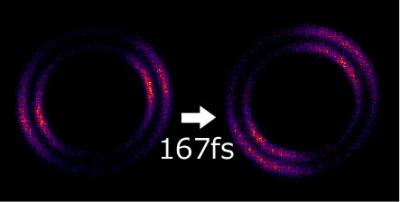A 'movie' of ultrafast rotating molecules at a hundred billion per second

Image 1: "Snapshots" of ultrafast rotating nitrogen molecules at a hundred billion per second (femtosecond = a quadrillionth part of one second). Credit: IMS/NINS
Can you imagine how subnano-scale molecules make an ultrafast rotation at a hundred billion per second? Do the ultrafast rotating subnano-scale molecules show a wave-like nature rather than particle-like behavior?
The Japanese research team led by Professor Yasuhiro Ohshima at the Tokyo Institute of Technology, and Dr Kenta Mizuse at the Institute for Molecular Science, National Institutes of Natural Sciences, successfully took sequential “snapshots” of ultrafast unidirectionally rotating molecules at a hundred billion per second.
To visualize such an ultrafast molecular rotation, the team developed a Coulomb explosion imaging setup with regulating rotational direction by a pair of time-delayed, polarization-skewed laser pulses. In the sequential “snapshots”, the team successfully reported high-resolution direct imaging of direction-controlled rotational wave packets (RWPs) in nitrogen molecules, and the quantum wave-like nature was successfully observed. The result will guide more sophisticated molecular manipulations, such as an ultrafast molecular “stopwatch”. This result is published in Science Advances (July 3rd, 2015)
Rotational wave packets (RWPs) are time-varying states of motion of rotating microscopic objects like molecules, and they change shapes in an ultrafast time scale, typically some parts in a trillion second. More importantly, because RWPs are governed by the fundamental microscopic physical laws, quantum mechanics, they show a wave-like nature, much different from what macroscopic things exhibit. So, RWPs are one of the ideal play grounds for examining the connection between quantum and classical worlds.
In the present study, the RWPs were created by using a pair of ultrafast laser pulses, of which mutual delay and polarization were properly adjusted. In addition, by using a specially designed ion-imaging setup, the team got images of unidirectional RWPs at a viewing angle that the previous 2D imaging studies could not adopt. As a result, the team succeeded in recording a series of images of time-varying molecular angular distribution with high-spatial resolution, which is nothing but a “movie” on the RWPs with a defined sense of rotation. The movie clearly shows the wave-like nature of the RWPs.
Multiple running waves get together at some time to give a highly concentrated spatial orientation and split after a while into parts having different angular velocities, while the overall movement keeps rotating in one direction. This propagation of wave packets may well be expected as a pedantic example of a simple quantum system like rotating molecules in free space, for which mutual interaction is essentially inoperative. Nevertheless, it has never been visualized experimentally so far.
There have been many proposals for novel application of unidirectional RWPs. For instance, unidirectionally rotating molecular gas ensembles are expected to make sophisticated polarization shaping of ultrafast light pulses. In addition, unidirectional RWPs exhibiting cogwheel like motion are expected to be used as a “stopwatch” to measure the precise time difference between pulses from two independent ultrafast laser systems.
In a purely fundamental point of view, on the other hand, it is so challenging to experimentalists to explore how the wave-like nature of RWPs is approaching the particle-like behavior for a macroscopic object. It is also of great interest to experimentally track the loss of the wave-like character by a mutual or external interaction. Professor Ohshima said, “We hope our high-resolution RWP imaging to be applicable in making a movie on such crossovers from quantum to classical worlds.”
Article:
Quantum unidirectional rotation directly imaged with molecules
Kenta Mizuse, Kenta Kitano, Hirokazu Hasegawa, and Yasuhiro Ohshima
Science Advances, July 3rd, 2015
DOI: 10.11126/sciadv.1400185
Contacts:
Professor Yasuhiro Ohshima
Department of Chemistry, Graduate School of Science and Engineering, Tokyo Institute of Technology
TEL +81-3-5734-2899
FAX +81-3-5734-2264
E-mail ohshima@chem.titech.ac.jp
http://www.
Press contacts:
Public Relations, Institute for Molecular Science, Natural Institutes of Natural Sciences
TEL/FAX: +81-564-55-7262
E-mail: kouhou@ims.ac.jp
Center for Public Affairs and Communications, Tokyo Institute of Technology
TEL: +81-3-5734-2975
FAX: +81-3-5734-3661
Email : media@jim.titech.ac.jp
Media Contact
All latest news from the category: Life Sciences and Chemistry
Articles and reports from the Life Sciences and chemistry area deal with applied and basic research into modern biology, chemistry and human medicine.
Valuable information can be found on a range of life sciences fields including bacteriology, biochemistry, bionics, bioinformatics, biophysics, biotechnology, genetics, geobotany, human biology, marine biology, microbiology, molecular biology, cellular biology, zoology, bioinorganic chemistry, microchemistry and environmental chemistry.
Newest articles

NASA: Mystery of life’s handedness deepens
The mystery of why life uses molecules with specific orientations has deepened with a NASA-funded discovery that RNA — a key molecule thought to have potentially held the instructions for…

What are the effects of historic lithium mining on water quality?
Study reveals low levels of common contaminants but high levels of other elements in waters associated with an abandoned lithium mine. Lithium ore and mining waste from a historic lithium…

Quantum-inspired design boosts efficiency of heat-to-electricity conversion
Rice engineers take unconventional route to improving thermophotovoltaic systems. Researchers at Rice University have found a new way to improve a key element of thermophotovoltaic (TPV) systems, which convert heat…



